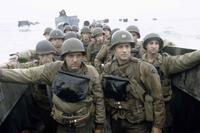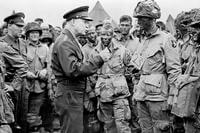Motor Machinist's Mate First Class William F. Trump was a Coast Guardsman and steeled veteran of amphibious landings long before departing for Normandy. He landed troops at Sicily in 1943 and Salerno later that same year. When he arrived in England, he began to memorize the landmarks that would help him drive his landing craft toward his target beach in France. Like most troops, he didn't know when that would be, but he knew the invasion of Europe would be a pivotal point in the war.
Operation Overlord was one of the most complex military operations in the history of modern warfare. On June 6, 1944, nearly 200,000 sailors landed some 156,000 soldiers on five beaches along the Normandy coast. The D-Day invasion was the largest amphibious invasion in military history, but it was only the first footprint of the Allies' liberation of Nazi-occupied Europe. By the end of August 1944, more than two million Allied troops would cross the English Channel into France, along with tanks, fuel, supplies and other war materiel.

The landings were dubbed Operation Neptune. The soldiers and sailors who assaulted the German defenders' positions are rightfully remembered for their heroism and sacrifice. The Nazis began fortifying their "Atlantic Wall" in 1942 and positioned more than 50,000 troops and 170 coastal guns in its maze of concrete and steel. Along with the Army and Navy, thousands of Army Air Forces aircraft dropped more than 13,000 paratroopers and 3,000 glider troops into Normandy. An estimated 306 Marines were also present in the English Channel, setting off seaborne mines and ready to land if needed.
The Coast Guard is known today as a maritime law enforcement and protective force. One of its primary missions is protecting coastal areas, minimizing losses to life and property by searching for and rescuing people in distress. On D-Day, Coasties were not only living up to their continued mission of saving lives, but many, like William F. Trump, were using their unmatched littoral skills to drop U.S. Army troops at their target beaches.

The Higgins Boats
At Normandy, Trump would crew an LCI (or "Landing Craft, Infantry"), a 158-foot-long and 23-foot-wide ship capable of ferrying up to 200 soldiers to the beaches. His mission didn't stop with the landing: He had to jump off his ship under fire and anchor a line onto the shore to help the disembarking soldiers find their way onto the beach.
But the MVP of D-Day -- and according to Allied Supreme Commander Gen. Dwight D. Eisenhower, the entire war -- wasn't the LCI, but the Higgins boat. Officially designated "Landing Craft, Vehicle and Personnel," these unique boats were one of the major technological innovations of the war. They were nicknamed "Higgins boats" for their creator, New Orleans industrialist Andrew Jackson Higgins, who modified shallow water Eureka Craft boats used in oil and gas production to meet the needs of the U.S. Army. Because of the Higgins boat, amphibious invasions were no longer centered on heavily defended ports, and the Allies could choose their target beaches at will.
The versatility of the Higgins boat was on display at Normandy. At Utah Beach, the Coast Guard's USS Bayfield assault transport was the "nerve center" for the entire Utah sector, landing much of the U.S. Army 4th Infantry Division. Coast Guard vessels also landed British and Canadian troops along with supplies at beaches Gold, Juno and Sword. But the Coast Guard was centered around assault group O-1, led by the USS Samuel Chase, on the eastern areas of Omaha Beach, where it would land the Army's 1st Infantry Division, "The Big Red One."
When the time came to load the transports and cross the English Channel, the landing craft were piloted by highly trailed and thoroughly drilled Coast Guardsmen, many of whom were veterans of other amphibious invasions. Over 11 miles of rough, choppy seas, the Higgins boats full of soldiers pitched and rolled as they made their way to their target beachheads, dodging mines and obstacles as they approached. The coxswains driving the boats had to land six transports for every 3,000 yards of beach, all on an exact timetable.

The first wave consisted of eight assault battalions. Two minutes later, a demolition team would land, having just 30 minutes to clear obstacles. From 7 a.m. until 9:30 a.m., the Coast Guard (along with some Navy sailors) would land a new wave every 10 minutes. At 8:30 a.m., LCIs manned by men like Trump began landing their forces. Unlike the Higgins boats, the LCIs could tear through beach obstacles, as long as they weren't mined.
By 11 a.m., the Samuel Chase had offloaded the entire 1st Infantry Division. Its landing craft, having dispatched its troops and supplies, changed its mission. They then joined the rescue effort.
The Rescue Flotilla
Despite the massive logistical complexity of the operation, just a few weeks before the invasion, President Franklin D. Roosevelt "suggested" Operation Overlord needed a rescue flotilla. Naturally, Chief of Naval Operations Ernest J. King tapped the Coast Guard to man such a rescue team. The Coast Guard at the time operated a number of 83-foot patrol boats along the United States' Atlantic Coast. Nicknamed the "Matchbox Fleet," they were simple wooden ships running on gasoline engines, but they had capable crews and were shipped to England.
Some 60 of these "Matchbox" ships were renamed Rescue Flotilla One, and its crewmen were trained in amphibious maneuvers such as small boat handling and ship-to-shore movement, as well as beach landings and retractions. The fleet was split in half between the British and Canadian sectors and the American sector. Roosevelt's suggestion was remarkably prescient: The Coast Guard would save 400 men on D-Day alone. By the end of the year, that number would balloon to more than 1,400.
Their lifesaving day began before the Allies ever set foot on the beach. At Gold, Juno and Sword beaches, the Matchbox Flotilla spent D-Day rescuing British and Canadian troops from the choppy channel, ferrying personnel and, as they got closer to the beaches, pulling survivors out of burning landing craft. Off Omaha and Utah Beach, they also pulled men from the waters, but the Coast Guardsmen were 2,000 yards away from the action and did their rescue swimming under heavy machine-gun, mortar and artillery fire.
Proximity to the beach did not determine anyone's safety on D-Day. Coast Guard landing ships were hit by seaborne mines, 88-millimeter artillery shells and countless bullets. One LCI was hit 25 times. Another beached on a sandbar, allowing the Germans to pour artillery onto it. Ships burned, forcing the crews and hundreds of troops to abandon them in the middle of the channel. Those who bailed out closer to the beaches were mowed down by unrelenting machine-gun fire.

Meanwhile, Coast Guard-manned transports lay offshore, staffed by corpsmen and doctors from the U.S. Public Health Service. Coast Guard landing craft returned from the beaches and surrounding waters with wounded soldiers and sailors. The assault transport USS Joseph T. Dickman sickbay was filled up so fast, it had to return to Plymouth in England to drop the troops off.
The Coast Guard's mission in Operation Overlord wasn't over on D-Day. The USS Bayfield spent the next 19 days directing operations near Utah Beach. Capt. Miles Imlay, who directed traffic toward the beach all morning, would go on to manage all the Allied traffic coming into Europe from Britain and elsewhere after artificial harbors were constructed and the invasion moved inland.
There were 99 vessels crewed by Coasties during Operation Neptune. By midnight, 18 Coast Guardsmen would be dead with another 38 wounded. The Coast Guard lost more vessels that day than any other day in its history -- but no one else was more qualified for the variety of work it was asked to do that day.
"We didn't think twice about going to help out a shipmate in distress," said one Coast Guard commander. "Ship spirit is at its best when the enemy is making it tough for us."
Want to Learn More About Military Life?
Whether you're thinking of joining the military, looking for post-military careers or keeping up with military life and benefits, Military.com has you covered. Subscribe to Military.com to have military news, updates and resources delivered directly to your inbox.
























